 Weird Stuff
Weird Stuff  Weird Stuff
Weird Stuff  Politics
Politics 10 Political Scandals That Sent Crowds Into the Streets
 Weird Stuff
Weird Stuff Ten Bizarre Facts About The Doge Meme
 Our World
Our World 10 Ways Your Christmas Tree Is More Lit Than You Think
 Movies and TV
Movies and TV The 10 Coolest Stars to Set Sail on The Love Boat
 History
History 10 Things You Didn’t Know About the American National Anthem
 Technology
Technology Top 10 Everyday Tech Buzzwords That Hide a Darker Past
 Humans
Humans 10 Everyday Human Behaviors That Are Actually Survival Instincts
 Animals
Animals 10 Animals That Humiliated and Harmed Historical Leaders
 History
History 10 Most Influential Protests in Modern History
 Weird Stuff
Weird Stuff 10 Funny Ways That Researchers Overthink Christmas
 Politics
Politics 10 Political Scandals That Sent Crowds Into the Streets
 Weird Stuff
Weird Stuff Ten Bizarre Facts About The Doge Meme
Who's Behind Listverse?

Jamie Frater
Head Editor
Jamie founded Listverse due to an insatiable desire to share fascinating, obscure, and bizarre facts. He has been a guest speaker on numerous national radio and television stations and is a five time published author.
More About Us Our World
Our World 10 Ways Your Christmas Tree Is More Lit Than You Think
 Movies and TV
Movies and TV The 10 Coolest Stars to Set Sail on The Love Boat
 History
History 10 Things You Didn’t Know About the American National Anthem
 Technology
Technology Top 10 Everyday Tech Buzzwords That Hide a Darker Past
 Humans
Humans 10 Everyday Human Behaviors That Are Actually Survival Instincts
 Animals
Animals 10 Animals That Humiliated and Harmed Historical Leaders
 History
History 10 Most Influential Protests in Modern History
10 Strange Creepy-Crawly Medical Treatments That Actually Work
Most of the time, we tend to think of insects as annoying little things invading our homes—that is if we even think of them at all. And the word “worm” typically evokes thoughts of earthworms or of a particularly unsettling sea creature, depending on your interests.
Although it can be frustrating to have a fly or a wasp buzzing around your room when you’re trying to get to sleep at night, there are little critters out there that actually play a big part in helping to keep us humans alive by contributing to treatments for various illnesses and diseases. The following are ten examples of medical treatments involving the use of various creepy-crawlies that seem pretty strange on paper but are actually very effective.
10 Wasp Venom Cancer Treatment
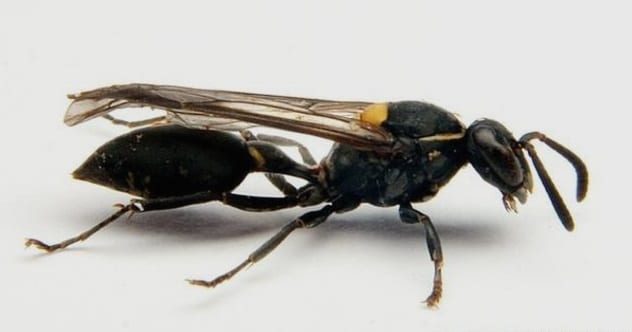
If there is any one single disease that we are desperate to find a cure for, it is cancer, so any breakthrough in this area is something that has to be welcomed—even if it involves using venomous wasps. Scientists now believe that the venom of a particular type of wasp that is found in Brazil contains a toxin, dubbed Polybia-MP1, capable of killing off cancer cells while leaving normal cells completely unaffected.[1] The type of wasp in question is Polybia paulista, which is extremely common in Southeastern Brazil. The toxin works by taking advantage of the weaker spots in these cancerous cells, created by their abnormal mix of lipids, and penetrating them to mix with the fats. The end result is that molecules the cancer cells need to be able to survive and spread leak away.
The prospect of being injected with wasp venom doesn’t sound very enjoyable, but most of us would put up with it if doing so gave us a better chance of surviving one of the deadliest diseases around. At the moment, this potential cure is still very much in the research and testing stage when it comes to humans, but it has shown itself to be effective during these tests and could prove to be a major breakthrough.
9 Ant Head Stitches
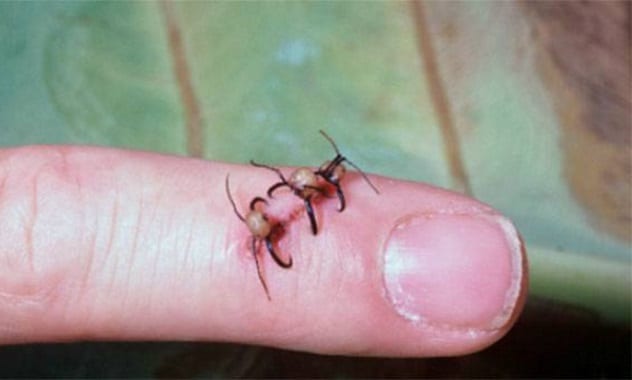
When you’re lying on the ground bleeding profusely from an injury of some kind, you probably won’t care very much what is used to stitch the wound up—even if it’s the heads of decapitated ants. Driver ants are a genus that is mainly found in Africa. They are known for their very large, sharp jaws that can bite into flesh and be difficult to get out—-not to mention incredibly painful for the person who has been bitten. This alone would seem like a pretty good reason to cut the heads off them, but there are also medical reasons for doing so, as removing their heads can provide us with a temporary suture when we’ve hurt ourselves. (This can be done with other types of ant as well.)
It is a fairly grim process for both the injured person and the ant, as you have to get the ant to bite you in the affected area and then twist it to break the body from the head, with the jaws and severed head serving as a makeshift suture.[2] This rather grisly but effective way of stitching up wounds was depicted in the 2006 movie Apocalypto.
8 Parasitic Worm Drinks
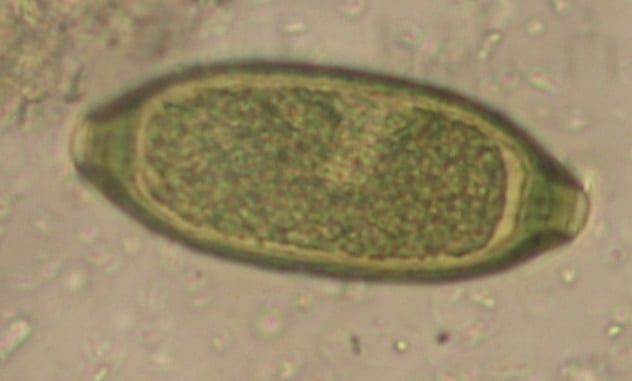
Ulcerative colitis is a condition that causes bowel inflammation, and it can often be every bit as painful as it sounds for those who suffer from it. Furthermore, while it is possible to reduce the effects of this condition via options like medication and changes to your nutrition and diet, there is no actual cure available at the moment. That may change over the next few years, however, as a research team led by Dr. Joel Weinstock has uncovered a potential treatment that has shown signs of being pretty effective—swallowing drinks that have parasitic pig worm eggs in them.
Weinstock and his researchers began by testing out the treatment on a single patient with a chronic bowel condition, adding the eggs to a soft drink, and the patient experienced an improvement. Larger trials saw drinks containing the worms given to 54 people with ulcerative colitis and 29 with Crohns disease, with 47.8 percent of the former and 72.4 percent of the latter finding that their conditions got better in the following weeks.[3] The theory behind why it works is that these tiny worms are actually supposed to be in our stomachs to help regulate our immune systems and that by getting rid of them through advances in hygiene, we have left ourselves more at risk to immune-based diseases like ulcerative colitis.
7 Powdered Centipedes

The use of powdered centipedes as a health supplement originated in China, where it is called wu gong. It’s linked to the liver meridian and is used in the treatment of a number of physical ailments—including convulsions, seizures, and lockjaw. Centipedes in powder form also have a history of being used by the Chinese as a cancer treatment dating back hundreds of years.
Although some people may be skeptical of traditional Asian medicine, the ability of wu gong to prevent the development of tumors has been recognized by scientists in the West as well. These scientists conducted tests on rats and mice with cancers, and the results showed that wu gong extract had a real effect on the development of the tumors—suppressing the growth of the cancerous cells.[4] While powdered centipede is not being used as a treatment for cancer among human beings in Western countries at the moment, it may just be possible that we are lagging behind traditional Eastern medicine on this occasion.
6 Flesh-Eating Maggots
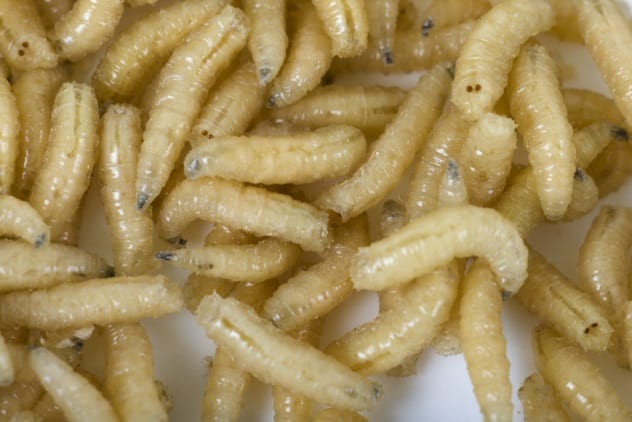
As if finding out that the heads of ants can be used to stitch wounds wasn’t strange enough, it is also possible to clean the wound before stitching by tipping maggots into it. This may sound incredibly gross and painful, but in fact, maggot therapy is a recognized form of treatment for certain types of wounds, and the US Food and Drug Administration gave its approval to their use for this purpose in 2004. The history of cleaning wounds with live maggots goes back much further than that, though; doctors treating soldiers in Napoleon’s army employed this rather unorthodox form of cleansing, as did a surgeon from the US named William Baer during World War I.
The maggots actually perform two different functions in treating wounds: Firstly, they eat away all of the infected or dead tissue around the wound while leaving the healthy tissue alone; secondly, they produce secretions that keep the part of our immune system that fights off pathogens, known as the “complement response,” balanced, helping to get rid of infections.[5] You also do not have to worry about them crawling away into the body and popping out of your nose at a later date, because they are kept inside the wound area by a “cage” made of nylon net and tape.
5 Silkworm Heart Patches
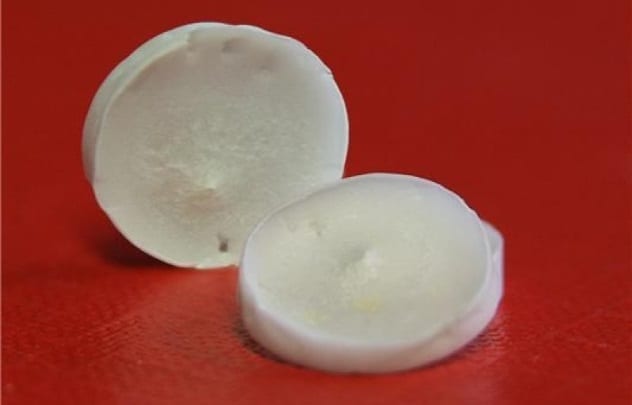
Silkworms have a slightly magical quality to them as it is, but what most people do not realize is that the silk they produce can make a real difference to those who have had heart attacks. We all know that people often survive heart attacks, but they are left with permanently damaged hearts due to the inability of cardiac muscle tissue to regenerate after it is killed by an attack. Science has been working for a long time to create patches that allow for the growth of new cells, and a number of different materials have been experimented with and abandoned because the immune system rejected them or because they were too brittle. A possible solution, however, has been found in a place we would hardly expect to find it: the tasar silkworm.
A group of scientists based at the Indian Institute of Technology produced disks the size of a coin out of this silk, which turned out to be better for making heart patches due to their coarse texture and the presence of proteins which help cardiac muscle cells to knit together.[6] The treatment was carried out successfully on rats, but before we humans can benefit from it, a way of getting enough of the cardiac cells needed to start the process has to be figured out.
4 Blister Beetle Wart Removers
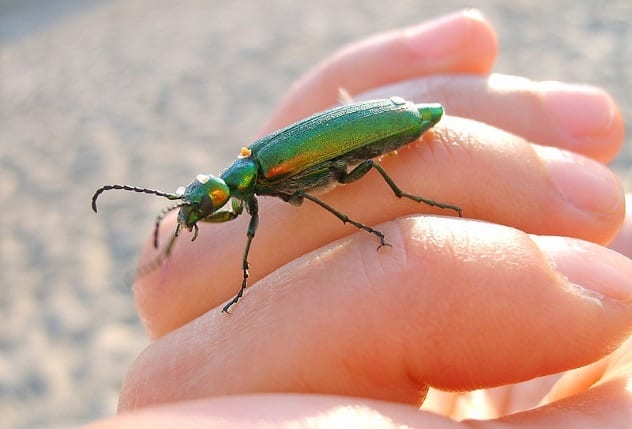
Having a wart on a visible part of your body is one of the more embarrassing medical conditions to suffer from, and that means most of us would accept any treatment that would get rid of it—including ointment made from beetle secretions. Various species of blister beetles are found throughout the world and produce a substance that is called cantharidin. This substance causes blistering when it comes into contact with human skin, which is bad in most circumstances but can make it a useful way of removing a wart.
This form of treatment began to be used by dermatologists during the 1950s. Nowadays, it is generally used when other options—such as freezing the wart using liquid nitrogen or putting salicylic acid on it—have failed. The treatment sees the cantharidin rubbed on the wart, which then has a bandage put over it. This is removed after around six hours, and the affected area is washed with soap. The skin will either blister or scab, and when the blister is dry, the wart will just drop off.[7]
3 Leeches

During the 19th century, leeches were used the US, Asia, and Europe to drain blood from patients out of a misguided belief that a range of illnesses could be cured in this way, but we now know that leeches do actually have a legitimate role to play in health care. In modern medicine, leeches are used mostly in helping patients heal following skin grafts, as they are able to suck up blood that has built up inside veins—or under the graft—thereby restoring blood circulation and preventing cells from dying.
This is not the only condition that can be treated using leeches, though. Scientific studies have found that putting them on the knees of patients with arthritis greatly reduces the pain they suffer, while a study from Russia found that the secretions in the saliva of medicinal leeches can be helpful in treating ear conditions like tinnitus. This particular treatment sees one leech placed behind the ear of the patient and another on the jaw in front of it, but what is even stranger is that we do not really know why it works because doctors are not clear about what causes tinnitus in the first place.[8]
2 Caterpillar Flu Vaccine
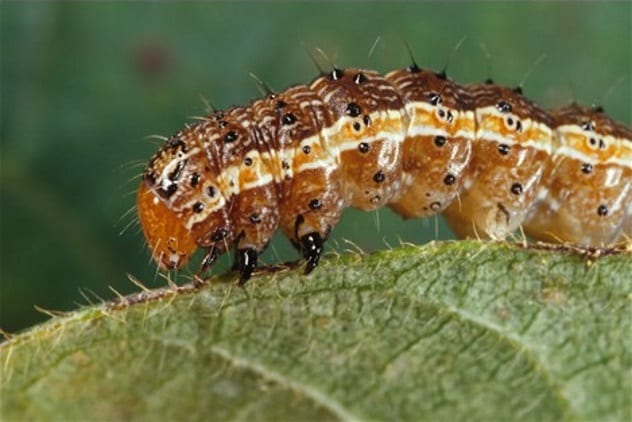
The flu is an illness we all get sometimes, and although it is not usually life-threatening, it is unpleasant. Flublok Quadrivalent is what is known as a recombinant flu vaccine, which means that a vaccine virus grown from an egg is not used in its production. It is the only flu vaccine of this type that is currently on the market in the US, and clinical trials have shown that those who were given it were 31 percent less liable to catch flu than those given vaccines grown from eggs. Flublok also has an ingredient that makes it stand out even more—armyworm caterpillar cells.
Part of the flu virus is grafted onto a virus from an insect, and this is then injected into cells from the armyworm, where it grows and develops into the substances used to create the finished vaccine. Ovary cells are used for this process, and they have to be taken when the caterpillar is in the pupal stage. Developing the vaccine this way means that it can potentially be produced a lot more quickly than using the traditional method.[9]
1 Bee Honey Burn Cream

Honey is nice to eat, but it is also surprisingly useful in treating a range of different illnesses and injuries. For example, a poultice of honey is a recognized way of curing burns, with the honey being placed on the burned area after cold water. It keeps the air away from the burned skin, which makes it less painful. It also rehydrates the skin in addition to possessing antiseptic qualities that help prevent it from becoming infected. The type of honey most commonly used for this treatment is Manuka, which is made by Apis mellifera, aka the European honey bee, which was introduced to New Zealand by settlers from Europe and is now generally found in that country.
Manuka honey isn’t just good for treating burns, as it has also proven effective with pressure ulcers and bacterial infections. The US Food and Drug Administration officially approved it for treating wounds over a decade ago. Clinical trials have also found that it helped burns to heal more rapidly than dressings that are made of film or gauze while cutting down on inflammation, scarring, and smell during recovery.[10]
I am a freelance writer based in Dundee, Scotland. I also make short films under the name Wardlaw Films.
Read about more strange medical treatments on 10 Really Weird Chinese Medical Treatments And Their Effects and Top 10 Bizarre Ancient Roman Medical Treatments.








